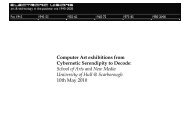Fractals and an Art for the Sake of Science â Mandelbrot
Fractals and an Art for the Sake of Science â Mandelbrot
Fractals and an Art for the Sake of Science â Mandelbrot
You also want an ePaper? Increase the reach of your titles
YUMPU automatically turns print PDFs into web optimized ePapers that Google loves.
<strong>Fractals</strong> <strong><strong>an</strong>d</strong> <strong>an</strong> <strong>Art</strong><br />
<strong>for</strong> <strong>the</strong> <strong>Sake</strong> <strong>of</strong> <strong>Science</strong><br />
Benoit B. M<strong><strong>an</strong>d</strong>elbrot<br />
T he artist <strong><strong>an</strong>d</strong> <strong>the</strong> artis<strong>an</strong> are <strong>of</strong>ten hard to tell<br />
apart. For example, objects that were in principle me<strong>an</strong>t to<br />
be utilitari<strong>an</strong>-be it folk architecture, religious imagery, or<br />
drawings <strong><strong>an</strong>d</strong> photographs <strong>of</strong> flowers, birds or water eddies-<strong>of</strong>ten<br />
end up being regarded as genuine works <strong>of</strong> art.<br />
It may become hard to distinguish <strong>the</strong>m from works in which<br />
science was used almost as <strong>an</strong> excuse <strong>for</strong> artistic creativity.<br />
Thus, art faces us with broad possibilities. We are presented<br />
with innumerable works <strong>of</strong> art <strong>for</strong> <strong>the</strong> sake <strong>of</strong> commerce: ob-<br />
jects have been commissioned under precise specifications<br />
to be useful-to decorate, to educate, to flatter, to entertain,<br />
to impress or to persuade. We are also presented with a few<br />
works created strictly as art <strong>for</strong> art's sake. And we also know<br />
<strong>of</strong> m<strong>an</strong>y possibilities that lie, so to say, in-between.<br />
Does ma<strong>the</strong>matics relate in <strong>an</strong>y way to <strong>the</strong>se familiar<br />
<strong>for</strong>ms <strong>of</strong> plastic art? The classic shapes <strong>of</strong> geometry are<br />
hailed <strong>for</strong> <strong>the</strong>ir conceptual beauty, but <strong>the</strong>y seem mostly to<br />
reside in <strong>the</strong> imagination <strong>of</strong> skilled practitioners. Although<br />
<strong>the</strong> popular poet Edna Saint Vincent Millay proclaimed that<br />
"Euclid Gazed on Beauty Bare" <strong><strong>an</strong>d</strong> although Euclid's<br />
geometry was <strong>of</strong> central import<strong>an</strong>ce to painters <strong>of</strong> <strong>the</strong> Itali<strong>an</strong><br />
Renaiss<strong>an</strong>ce during <strong>the</strong> brief period when perspective<br />
was being 'invented', to <strong>the</strong> eye <strong>of</strong> those unschooled in<br />
ma<strong>the</strong>matics, <strong>the</strong> beauty <strong>of</strong> Euclid's geometry is bare <strong><strong>an</strong>d</strong><br />
dry to a fault. At <strong>the</strong> least it lacks scope <strong><strong>an</strong>d</strong> visual variety<br />
when compared with those excesses <strong>of</strong> ei<strong>the</strong>r nature or <strong>the</strong><br />
fine arts, which everyone seems tempted to call 'baroque'<br />
or 'org<strong>an</strong>ic'.<br />
Today, however, <strong>the</strong>re is more to geometry th<strong>an</strong> Euclid.<br />
During <strong>the</strong> 1970s it was my privilege to conceive <strong><strong>an</strong>d</strong> develop<br />
fractal geometry [1], a body <strong>of</strong> thoughts, <strong>for</strong>mulas <strong><strong>an</strong>d</strong> pictures<br />
that may be called ei<strong>the</strong>r a new geometry <strong>of</strong> nature or a<br />
new geometric l<strong>an</strong>guage. And <strong>the</strong> reason why it is worth discussing<br />
here is that I have discovered that, most surprisingly<br />
<strong><strong>an</strong>d</strong> without <strong>an</strong>y prodding, this new geometric l<strong>an</strong>guage has<br />
given rise to a new <strong>for</strong>m <strong>of</strong> art. I propose here to make a few<br />
disjointed comments on its account. M<strong>an</strong>y readers are<br />
bound to be familiar with fractal art, <strong><strong>an</strong>d</strong> <strong>the</strong> volume in<br />
which this paper appears may well contain some new examples<br />
from <strong>the</strong> 1989 SIGGRAPH show; never<strong>the</strong>less, close<br />
familiarity with <strong>the</strong> subject is not expected from <strong>the</strong> reader.<br />
The bulk <strong>of</strong> fractal art has not been commissioned <strong>for</strong> <strong>an</strong>y<br />
commercial purpose, even though all <strong>the</strong> early work was<br />
done at IBM. And it has not necessarily been touched by<br />
es<strong>the</strong>tic sensibility. There<strong>for</strong>e, we shall argue that fractal<br />
geometry appears to have created a new category <strong>of</strong> art, next<br />
to art <strong>for</strong> art's sake <strong><strong>an</strong>d</strong> art <strong>for</strong> <strong>the</strong> sake <strong>of</strong> commerce: art <strong>for</strong><br />
<strong>the</strong> sake <strong>of</strong> science (<strong><strong>an</strong>d</strong> <strong>of</strong> ma<strong>the</strong>matics).<br />
Benoit B. M<strong><strong>an</strong>d</strong>elbrot (ma<strong>the</strong>matici<strong>an</strong>, research fellow), Physics Department, IBM TJ.<br />
Watson Research Center, Yorktown Heights, NY, 10598, U.S.A.; Ma<strong>the</strong>matics<br />
Department, Yale Universitv, New Haven CT 06520, U.S.A.<br />
ABSTRACT<br />
new <strong>for</strong>m <strong>of</strong> art redefines<br />
<strong>the</strong> boundary between 'invention'<br />
Fractal art <strong>for</strong> <strong>the</strong> sake <strong>of</strong> sci- <strong><strong>an</strong>d</strong> 'discovery', as understood in<br />
ence is indissolubly based on <strong>the</strong> sciences, <strong><strong>an</strong>d</strong> 'creativity', as<br />
<strong>the</strong> use <strong>of</strong> computers. It could understood in <strong>the</strong> plastic arts. C<strong>an</strong><br />
not possibly have arisen be<strong>for</strong>e<br />
pure geometry be perceived by <strong>the</strong><br />
'm<strong>an</strong> in <strong>the</strong> street' as beautiful? To<br />
<strong>the</strong> hardware was ready <strong><strong>an</strong>d</strong> <strong>the</strong> be more specific, c<strong>an</strong> a shape that<br />
s<strong>of</strong>tware was being developed; is defined by a simplequation or a<br />
that is, be<strong>for</strong>e <strong>the</strong> decade <strong>of</strong> <strong>the</strong> simple rule <strong>of</strong> construction be<br />
seventies. What a perceived by people o<strong>the</strong>r th<strong>an</strong><br />
pr<strong>of</strong>ound<br />
irony that this new geometers as having aes<strong>the</strong>tic<br />
geometry, value-namely, as being at least<br />
which everyone seems sponta- surprisingly decorative-or perneously<br />
to describe as 'ba- haps even as being a work <strong>of</strong> art?<br />
roque' <strong><strong>an</strong>d</strong> 'org<strong>an</strong>ic', should When <strong>the</strong> geometric shape is a fracowe<br />
its birth to <strong>an</strong><br />
tal, <strong>the</strong> <strong>an</strong>swer is yes. Even when<br />
unexpected fractals are taken 'raw', <strong>the</strong>y are<br />
but pr<strong>of</strong>ound new match be- attractive. They lend <strong>the</strong>mselves to<br />
tween those two symbols <strong>of</strong> <strong>the</strong> 'painting by numbers' that is surprisinhum<strong>an</strong>,<br />
<strong>the</strong> dry, <strong><strong>an</strong>d</strong> <strong>the</strong> tech- ingly effective, even in <strong>the</strong> h<strong><strong>an</strong>d</strong>s <strong>of</strong><br />
nical: namely, between ma<strong>the</strong><strong>the</strong><br />
r<strong>an</strong>k amateur. And <strong>the</strong> true<br />
artist's sensibility finds <strong>the</strong>m a<br />
matics <strong><strong>an</strong>d</strong> <strong>the</strong> computer.<br />
novel <strong><strong>an</strong>d</strong> attractive support.<br />
Be<strong>for</strong>e we describe <strong>the</strong> peculiarities<br />
<strong>of</strong> fractal geometry in<br />
more detail, it is good, <strong>for</strong> <strong>the</strong><br />
sake <strong>of</strong> contrast, to comment<br />
on examples <strong>of</strong> similar matches that have arisen in areas<br />
such as <strong>the</strong> study <strong>of</strong> water eddies <strong><strong>an</strong>d</strong> wakes. In <strong>the</strong>se cases,<br />
<strong>the</strong> input in terms <strong>of</strong> reasoning <strong><strong>an</strong>d</strong> programs is extremely<br />
complicated, perhaps more complicated even th<strong>an</strong> <strong>the</strong> output.<br />
In fact, one may argue that, overall, complication does<br />
not increase but ch<strong>an</strong>ges over from being purely conceptual<br />
to being partly visual, a ch<strong>an</strong>ge that is import<strong>an</strong>t practically<br />
<strong><strong>an</strong>d</strong> interesting conceptually. Fractal geometry, however,<br />
gives us something quite different. In fractal geometry, <strong>the</strong><br />
inputs are typically so extraordinarily simple as to look positively<br />
simple-minded. The outputs, to <strong>the</strong> contrary, c<strong>an</strong> be<br />
spectacularly complex. Again, while a contribution from <strong>an</strong><br />
artistic sensibility is not necessary, it is well rewarded.<br />
Let us hasten to raise a question. Since <strong>the</strong> inputs are so<br />
simple, why is it that fractal art failed to appear earlier <strong><strong>an</strong>d</strong><br />
in more traditional ways? The <strong>an</strong>swer lies in a 'Catch 22' situation.<br />
To draw <strong>the</strong> simplest fractal picture 'by h<strong><strong>an</strong>d</strong>' would<br />
have been feasible in principle, but would have required<br />
m<strong>an</strong>y person-years <strong><strong>an</strong>d</strong> would have been ridiculously expensive.<br />
Consequently, no one would have considered undertaking<br />
this task without having a fair adv<strong>an</strong>ce knowledge <strong>of</strong><br />
<strong>the</strong> result; yet <strong>the</strong> result could not even be suspected until<br />
one actually had per<strong>for</strong>med <strong>the</strong> task. And a sure way <strong>of</strong> being<br />
discouraged from ever undertaking it would have been to<br />
begin with <strong>an</strong>y one <strong>of</strong> <strong>the</strong> various definitions <strong>of</strong> fractals. Here<br />
is one in<strong>for</strong>mal definition I <strong>of</strong>ten use:<br />
<strong>Fractals</strong> are geometric shapes that are equally complex in <strong>the</strong>ir<br />
details as in <strong>the</strong>ir overall<strong>for</strong>m. That is, if a piece <strong>of</strong> a fractal is suitably<br />
magnified to become <strong>of</strong> <strong>the</strong> same size as <strong>the</strong> whole, it should look<br />
A<br />
? 1989 ISAST<br />
Pergamon Press plc. Printed in Jap<strong>an</strong>.<br />
0024-094X/89 $3.00+0.00<br />
LEONARDO, Computer<strong>Art</strong> in Context Supplemental Issue. pp. 21-24, 1989 21








